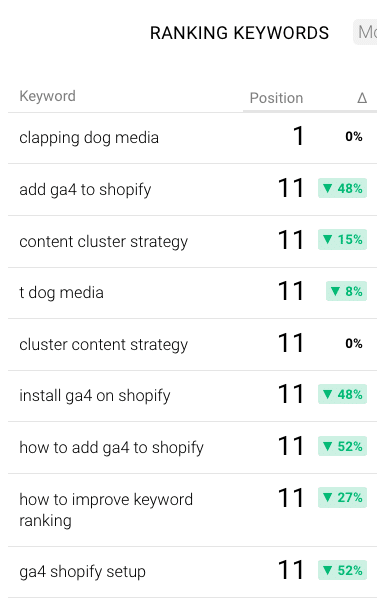Publishing high-value content on your website is the most effective way to grow organic traffic.
In fact, we believe in this so much that we don’t work with clients who don’t regularly post content that is engaging and is helpful to users.
Why is content important for SEO?
The easiest explanation is to look at this keyword growth chart.

This chart is the Organic Keywords Trend chart from SEM Rush for clappingdogmedia.com.
This graph shows the number of keywords that the site ranks for month over month, the more keywords a site ranks for the more opportunities for Google to find your site.
What is important to know is that we began to write articles regularly in November of 2022, before November our content was unplanned and very sporadic.
In November we committed to posting new content on a consistent basis. The plan was to post 2 articles in November and December and 4 in January and February. You can see in the chart below that we missed one and only posted 3 articles in February.
| Month | # of articles published | # of ranking keywords | Organic sessions |
| November | 2 | 48 | 80 |
| December | 2 | 94 | 121 |
| January | 4 | 171 | 204 |
| February | 3 | 314 | 373 |
Do you see the connection?
The number of articles posted on the site is directly related to the number of keywords that the site is ranked for and also directly related to the amount of organic traffic generated.
One super important aspect of this (that is not illustrated) is the quality of keywords that we now rank for. Because we write helpful, engaging and informative content, we rank for keywords that we want to be found for, we rank for keywords that drive new business.
This is SEO. This is what we do for clients, we help create this flywheel effect so that the content they write will enable them to rank for more quality keywords that will drive more traffic and get new clients.
This requires planning, data and strategy.
We are able to do this by creating an effective data-driven Content Plan.
A content plan, also referred to as an editorial calendar, is the plan of articles, podcasts and/or videos that a business creates and publishes on their website. An effective content plan will be data-driven and written for potential clients.
Each month here at Clapping Dog Media we create content plans for our clients and we measure the results.
We have over 30 long-term monthly clients so this is quite a lot of work.
We first take an inventory of what types of content they have on the site and then we dive in. The goal is to regularly create new content that fits into the steps outlined below.
If a client has a rich archive of content (2-3 years worth) then we will focus on steps 3 and 4. On the contrary if we are working with a new business or product, we will focus more on steps 1 and 2.
How We Create Content Plans for SEO Clients
Step 1: Create top-funnel content, or in other words create content that highlights your businesses expertise. These are articles for people who are in research mode.
This type of content is for people who need your services or product, but don’t know that your business exists yet. The first step in building out a content plan that attracts new clients, is to answer the questions these people have.
Here are some examples of articles for this step.
- Ultimate Guides: The Ultimate Guide to Buying the Best Mattress
- [Topic] vs [Topic]: WordPress vs Squarespace – Which Platform is Best for Your Business
- Best Practices: Step-by-Step Guide to Getting Your Baby to Sleep Through the Night
- Top # Tips: 6 Tips for Giving Your First Ted Talk
Step 2: Write middle-funnel blog posts. These are articles for searchers that have a problem and are looking for a solution.
We recently wrote a blog post about setting up Google Analytics 4 on several different platforms. Setting up GA4 can be tricky so we posted this article for all users who know they need to install the new version of Google Analytics, but need help.
This is a good example of how we targeted a problem (Installing GA4) and offered a solution and/or guidance.
Step 3. Look at Popular Pages. Once our plan has several informative and pain point focused articles, we then look at data. It is important to understand what content is popular and engaging on the site.
We will pull up the most popular pages and sort by blogs/podcasts and will also note the engagement time for articles.
This data is basically a crystal ball telling us what users like and telling us what we should write more of.
We will do more of the type of article (List, How-to, Ultimate Guide) as well as the subject.
Step 4. Look at New/Improving Ranking Keywords. Keyword data is also like looking into a crystal ball. This data tells us what keywords Google is ranking the site for. If keyword ranking improves, meaning Google puts your site higher on the search results list, then Google thinks your site is a good answer for that query.

We will do additional keyword research and suggest new ideas related to those topics.
Step 5. Competitive Analysis. At this point we have content that educates a wide audience (step 1), we have content ideas for users who have a problem, and need our solution (step 2), we have content that we know appeals to our target audience so we will create similar content to keep them engaged (steps 3 and 4) next is to win traffic from competition.
When we look at competition we use SEO tools like SEM Rush, but you can dig and research without the pricey software. Engage with your competitors’ site and see what articles are listed as the most popular. See what types of articles they write about and if you don’t have similar ones on your site add them to the content plan.
Most of our clients at Clapping Dog Media post 2-4 articles a month.
We systematically work through these 5 steps to build data driven and effective content plans. We can do it for you too, just reach out.
BONUS TIP
- Use your blog posts for content on other channels
- Write most blog posts with distribution in mind
- Turn the article into your next email newsletter
- Create videos to promote on TikTok/YouTube/IG
- Write a Twitter thread and promote the blog at the end
- Screenshot the Twitter thread for a LinkedIn carousel
- Extract and write 5+ LinkedIn posts from the article
- Extract and write 10+ Twitter posts from the article
Then repurpose and redistribute every 3+ months. Find out what resonated in your analytics and repurpose/redistribute the content again months later. Implement this over the next 6-12 months and watch what happens to your organic traffic and conversions.




